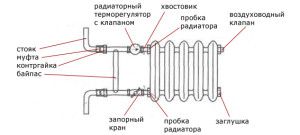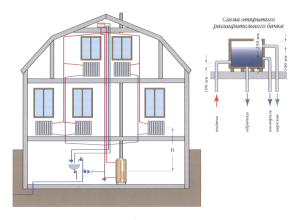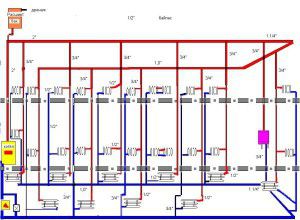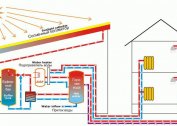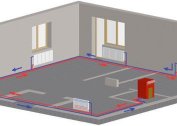How to choose the optimal distribution of heating pipes? First of all, it is necessary to analyze the operational characteristics of the system and the features of its functioning. In some cases, heating with top wiring and bottling will be the best option: systems and schemes for it should be selected with special care.
Features of the upper heating distribution
What is a similar trunk circuit? A typical top filling of the heating system differs from the bottom by the location of the supply pipe. It is located under the ceiling of the room or in the attic (for a one-story house).
Its use may be relevant in several cases. First of all, there are problems with installing lower horizontal pipes. This is due to the impossibility of laying the trunk. Another option when a two-pipe heating system with an upper wiring will be optimal is the installation of a gravity circuit. In this case, the water pressure from the supply riser will be evenly distributed over the connected radiators.
Experts highlight the following advantages of a top-mounted heating system:
- Minimal heat loss. In the upper part of the room, the temperature is always higher than in the lower. Therefore, heat transfer from the surface of the pipes will be compensated by increased heating of the air. As a result of this, most of the thermal energy will go to radiators;
- Simplified installation. It is noteworthy that a single-tube vertical heating system with an upper wiring can be installed directly under the ceiling or in the attic. But at the same time, the location of the furniture must be taken into account - it is undesirable for it to cover the supply pipes;
- Improved hydrodynamic performance of the system. A properly designed heating system with top filling has a minimum of branching and cornering.
However, you need to know the disadvantages of such a scheme. Piping will require more material than when using a bottom wiring system. As a result, the total volume of the coolant increases, installation of a boiler with increased power characteristics will be required.
For a single pipe vertical heating system with an installed upper wiring, the main problem may be the appearance of air jams. Therefore, on each radiator, Mayevsky taps must be installed.
Single pipe upper heating system
In what cases is it important to install a two-pipe vertical heating system with an upper wiring? Most often, this scheme is applicable for small houses up to 100 m². Consider an example of organization for the most common system with natural coolant circulation.
Depending on the method of connecting radiators, the heating circuit with the top filling of natural circulation is divided into two types - with passing and oncoming movement of the coolant.
Counter scheme
It is characterized by a serial connection of radiators and a different direction of water movement in the main and return pipes. In this case, the heating system is single-pipe with an upper wiring, the circuit of which has a number of features, differs in such parameters:
- Inability to adjust the degree of heating in each radiator;
- The dependence of the heating medium on the length of the line. The farther the radiator is installed from the boiler, the lower the temperature of the water entering it.To normalize the temperature in all rooms, batteries with a different number of sections should be installed;
- Compliance with the angle of inclination of the upper supply line. On average by 1 mp the slope in the direction of fluid movement should be 5-7 mm.
It is imperative that an expansion tank be provided for the top filling in the heating system. It is located at the highest point and performs several functions. The main one is pressure stabilization when heating the water in the pipes. If an open tank is installed, you can add coolant through it.
You can increase the water pressure with the help of an accelerating manifold - a vertical pipe installed immediately after the boiler. However, the minimum height of this element should be 3 m, which makes it impossible to install it in apartments.
Associated movement of water
In this case, the direction of movement of the hot and solidified coolant is the same. To improve operational specifications for the upper and lower heating distribution, experts recommend installing a bypass for each radiator. This is a straight pipe segment connecting the inlet and outlet pipes of the radiator. Shut-off valves are necessarily included in the bypass package. As an additional control element, you can install a thermostat. In this case, the battery may not reach the entire volume of the coolant. Adjustment is carried out using shut-off valves. For such a single-pipe heating circuit with an upper wiring, such positive qualities are inherent:
- The ability to carry out repair work without stopping the system. To do this, the entire flow of water is directed through the bypass;
- The installation of a thermostat together with a three-way valve forms a system for automatically controlling the degree of heating of the radiator.
However, the heating system with the upper wiring and the installed bass is higher in cost than an ordinary flowing one. This is due to the installation of additional materials and components.
The diameter of the bypass pipe should be 1 size smaller than the main line. In this way, you can avoid the situation when the entire volume of the coolant will flow along the backup circuit.
Top-pipe two-pipe heating system
The installation of a two-pipe heating system with an upper wiring minimizes or completely eliminates many of the above disadvantages. In this case, the radiators are connected in parallel.
For its installation, significantly more materials are needed, since two parallel lines are installed. Hot coolant flows through one of them, and cool down along the other. Why is this heating system with top filling preferred for private homes? One of the significant advantages is the relatively large area of the room. The two-pipe system can effectively maintain a comfortable temperature level in houses with a total area of up to 400 m².
In addition to this factor, for the heating circuit with an overflow, such important operational characteristics are noted:
- Uniform distribution of hot coolant over all installed radiators;
- The ability to install control valves not only on the battery strapping, but also on individual heating circuits;
- Installation of a water floor heating system. The collector system for the distribution of hot water is only possible with two-pipe heating.
Features of installation differ depending on the type of water circulation - natural or forced. For the first scheme of the top filling in the heating system, the installation of an expansion tank is provided. It should be located at the highest point in the pipe layout. Most often this is the attic of the house. Therefore, for the effective operation of heating, it is necessary to insulate if not the entire attic, then the tank body is mandatory.
The optimum capacity of an open expansion tank is 5% of the total volume of water in the system. Moreover, it should be filled only 1/3.
For the organization of forced top filling in the heating system, the installation of additional units is necessary - a circulation pump and a membrane expansion tank. The latter will replace the open expansion tank. But its installation location will be different. Sealed membrane models are mounted on the return line and always in the direct section.
The advantage of such a scheme is the optional observance of the slope of the pipelines, characteristic of the upper and lower wiring of heating with natural circulation. The required head will be generated by the circulation pump.
But does the two-pipe forced heating system with top wiring have flaws? Yes, and one of them is dependence on electricity. During a power outage, the circulation pump stops working. With a large hydrodynamic resistance, the natural circulation of the coolant will be difficult. Therefore, when designing a single-pipe heating system circuit with an upper wiring, all the necessary calculations must be performed.
You should also consider such features of installation and operation:
- When the pump stops, the reverse flow of the coolant is possible. Therefore, in critical areas, the installation of a check valve is necessary;
- Excessive heating of the coolant can cause a critical pressure indicator to be exceeded. In addition to the expansion tank, air vents are installed as an additional measure of protection;
- To increase the efficiency of the heating system with the upper pipe wiring, it is necessary to provide automatic replenishment of the coolant. Even a slight decrease in pressure below normal can lead to a decrease in heating of radiators.
Regardless of the selected scheme of the heating system with an overflow, two types of adjustment of the degree of heating of water must be provided for - quantitative (using shut-off valves) and qualitative (changing the boiler output). Then the heating operation will be not only effective, but also safe.
The video will help you visually see the difference for different heating schemes:


